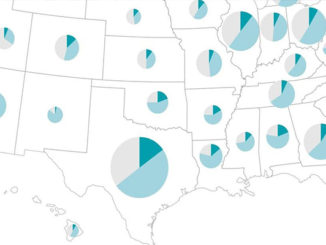
The word “abortion” only appears once in the 28-page Republican Party platform with the statement “[w]e will oppose Late Term Abortion, while supporting mothers and policies that advance Prenatal Care, access to Birth Control, and IVF.”
By Stephanie K. Pell, Brookings
Abortion is a top issue in the 2024 election, with a “growing share of voters in swing states now say[ing] abortion is central to their decision this fall,” according to Times/Siena College polls published in August. It is the “single most important issue” for women under 45.
On September 3, Vice President Kamala Harris began a “Fighting for Reproductive Freedom” bus tour in Florida, a state the Democratic Party has lost in the last two presidential elections, but which has abortion on the ballot this year. On November 5, citizens of Florida will be able to vote on an amendment that would restore legal access to abortion “before viability or when necessary to protect a patient’s health, as determined by the patient’s healthcare provider.” Florida currently has a six-week abortion ban, a law signed by Gov. Ron DeSantis in the wake of Dobbs.
The Harris bus tour began about a twenty-minute drive from Mar-a-Lago, the home of the former president who has declared responsibility for the fall of Roe under the Dobbs decision. The decision spawned multiple state abortion bans with severe repercussions upon a woman’s ability in ban states to receive critical or life-saving health care that may necessarily involve an abortion. At the September 10 presidential debate, Harris directly spoke to the post-Roe experiences of women suffering miscarriages and bleeding out in hospital parking lots because they couldn’t get treatment from doctors who were afraid of being prosecuted.
The other presidential candidate, former president Donald Trump, has bragged about overturning Roe v. Wade as a personal achievement of consummate importance. Public opinion polling shows, however, that the majority of Americans support legalized abortion. Moreover, the pro-reproductive rights position has won on abortion-related ballot measures following the Dobbs decision in conservative states like Ohio, Kansas, and Kentucky, and abortion measures are on the ballot this November in key states like Florida, Nevada, Colorado, and Arizona. Trump is now trying to downplay his involvement because the issue of abortion has become an albatross around the neck of the Trump campaign and the Republican Party itself. No wonder, then, in recent comments Trump has stated that abortion policy should be left to the states, and he has been publicly unwilling to endorse a nationwide abortion ban. At the debate, however, he repeatedly refused to answer whether he would veto legislation containing such a ban if it were presented to him as president, rejecting the question as an unlikely hypothetical while claiming he did the country “a great service” by helping overturn Roe.
In the wake of threats to in vitro fertilization (IVF) spurred by the Alabama Supreme Court decision that frozen embryos are children and the corresponding religious view held by some in the anti-abortion movement that a fertilized egg is a full-fledged person, Trump said both that he would mandate insurance companies cover IVF and the federal government would cover it for all Americans in need.
Attempting to persuade women who want their reproductive rights back, he suggested that Florida’s six-week abortion ban is “too short,” stating that he will be “voting that we need more than six weeks.” Later, however, his campaign walked this statement back, indicating that he “has not yet said how he will vote on the ballot initiative in Florida.” Trump attempted to rehabilitate his position on abortion further for his far right, evangelical base by spreading the disinformation that some states allow the legal execution of babies after birth. At the debate, he repeated this false statement, and one of the debate moderators fact-checked him on that. These are just a few examples of the ducking, bobbing, and weaving on abortion that Trump has been doing over the past few weeks.
But Trump’s attempts to obfuscate the abortion policy of his party and his future administration are laid bare by what is stated in the 2024 Republican Party platform and in the 2025 Presidential Transition Project (also known as Project 2025), a detailed blueprint for overhauling the executive branch, published by the Heritage Foundation, which involves at least 140 people who worked in the last Trump administration.
The word “abortion” only appears once in the 28-page Republican Party platform with the statement “[w]e will oppose Late Term Abortion, while supporting mothers and policies that advance Prenatal Care, access to Birth Control, and IVF.” But that statement must be understood in the context of the sentence that immediately precedes it: “We believe that the 14th Amendment to the Constitution of the United States guarantees that no person can be denied Life or Liberty without Due Process, and that the States are, therefore, free to pass Laws protecting those Rights.” By invoking the 14th Amendment to the Constitution in the context of abortion, the platform projects consistency with a religious belief that fertilized eggs, or so-called “unborn children” are full-fledged people deserving all of the rights and protections afforded by the U.S. Constitution. Neither abortion nor IVF, where some embryos may be discarded, is consistent with this “personhood” view. The limited and coded treatment of abortion in the platform is, however, consistent with Trump’s stated belief that the issue is harming the Republican Party and his candidacy with women.
But the Republican Party platform’s concise treatment of abortion should not be separated from Project 2025—a 922-page document replete with instances of the word abortion, along with detailed plans for how a Republican administration should promote “pro-life” policies and, in doing so, further curtail reproductive rights and access to reproductive healthcare.
Project 2025’s explicit anti-abortion positions and goals are summarized in the forward section of the document, which proclaims that “conservatives should gratefully celebrate the greatest pro-family win in a generation: overturning Roe v. Wade, a decision that for five decades made a mockery of our Constitution and facilitated the deaths of tens of millions of unborn children. But the Dobbs decision is just the beginning.”
A national abortion ban emerges as a prominent goal, as the document instructs that “[c]onservatives in the states and in Washington, including in the next conservative Administration, should push as hard as possible to protect the unborn in every jurisdiction in America. In particular, the next conservative President should work with Congress to enact the most robust protections for the unborn that Congress will support . . . .”
Some of the most noteworthy ideas and policies construed to achieve these outcomes presented in the rest of the document include:
- A series of actions focused on preventing access to medication abortion nationwide. It is important to recognize that medication abortion accounted for 63% of all abortions in 2023—and that number does not account for pills that were mailed to people in states with an abortion ban, so the overall percentage is likely higher. It can be a particularly useful way to circumvent abortion bans. From the perspective of Project 2025, “[a]bortion pills pose the single greatest threat to unborn children in a post-Roe world.” Accordingly, Project 2025 recommends, among other things, that the FDA “reverse its approval of chemical abortion drugs,” and “stop promoting or approving mail-order abortions.” It also recommends that the DOJ “enforce the Comstock Act,” a law passed in 1873 that would, if read literally, make the mailing of any kind of abortifacient unlawful, effectively resulting in a nationwide ban on medication abortion.
- Preventing both HHS and the CDC from treating or promoting abortion as health care. Consistent with this goal, and in furtherance of a “Life Agenda,” Project 2025 states that HHS should be known as the “Department of Life” through “explicitly rejecting the notion that abortion is health care.” Accordingly, Project 2025 recommends that the next Secretary of HHS eliminate the current HHS Reproductive Access Task Force and replace it with “a pro-life task force to ensure that all of the department’s divisions seek to use their authority to promote the life and health of women and their unborn children.” With respect to the CDC, Project 2025 recommends that it “should eliminate programs and projects that do not respect human life and conscious rights and that undermine family formation.” This would include the types of research it chooses to fund.
- Preventing any kind of federal funding from supporting abortion care, including helping women travel out of state to receive an abortion. Project 2025 would also prohibit Planned Parenthood or any other abortion provider from receiving Medicaid funds. Two steps recommended in furtherance of this goal are having HHS “[i]ssue guidance reemphasizing that states are free to defund Planned Parenthood in their state Medicaid plans” and “[p]ropose rulemaking to interpret the Medicaid statute to disqualify providers of elective abortion from the Medicaid program.”
In stark contrast, the Democratic Party platform, written when President Biden was still the Democratic candidate for president, has its own section on “Reproductive Freedom” that embraces the idea that abortion is health care. It begins by acknowledging that since the fall of Roe, “more than 20 states have imposed extreme and dangerous abortion bans—many of which include no exception even for rape or incest—that put the health and lives of women in jeopardy, force women to travel hundreds of miles for care, and threaten to criminalize doctors for providing the health care that their patients need and that they are trained to provide.”
The platform looks to the range of actions taken during the Biden-Harris administration as a foundation for continuing efforts to protect reproductive rights and health care. Some of the most notable actions mentioned, which are opposite of the policies promoted by Project 2025, include enabling pharmacies to dispense medication abortion and defending FDA approval of medication abortion in court, expanding reproductive health care for service members and veterans, defending access to emergency abortion care, challenging threats by a Republican attorney general to prosecute those who assist women traveling out of state for abortion care, and assisting states in expanding access under Medicaid for people who travel from states where they are denied access to abortion care.
Going forward, the platform states that Democrats will, among other things, work to restore abortion rights through legislation (assuming a Congress with sufficient Democratic control), protect the right to access IVF, strengthen access to contraception, and continue to support access to medication abortion. The platform also indicates that Democrats will work to repeal the Hyde amendment, which “restricts federally funded abortions under major federal health care programs.”
The contrast between the parties’ platforms and policies is clear. Simply put, the Democratic Party platform explicitly states that “President Biden, Vice President Harris, and Democrats are committed to restoring the reproductive rights Trump ripped away.” As the presidential candidate who has proudly claimed responsibility for the fall of Roe, Trump’s rhetoric resembles the defensive moves of a boxer ducking, bobbing, and weaving to slip an opponent’s punches: he has tried to disavow Project 2025, tried to obfuscate Republican Party positions and plans, and backtracked on some of his positions in an attempt to portray his future administration as “great for women and their reproductive rights.”



